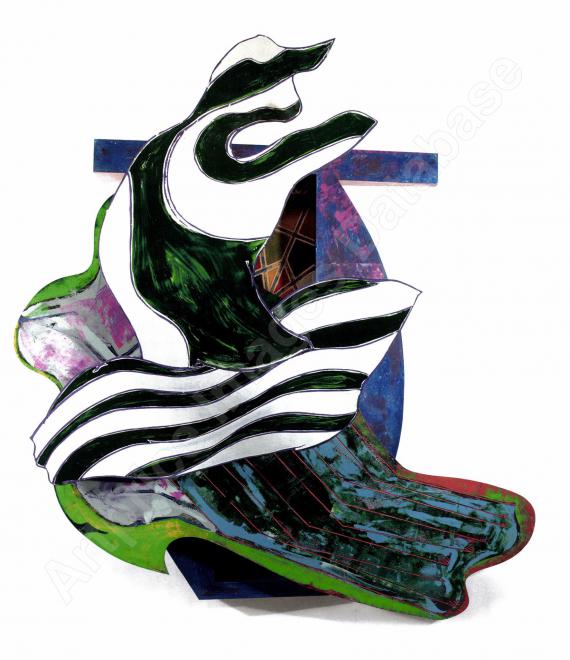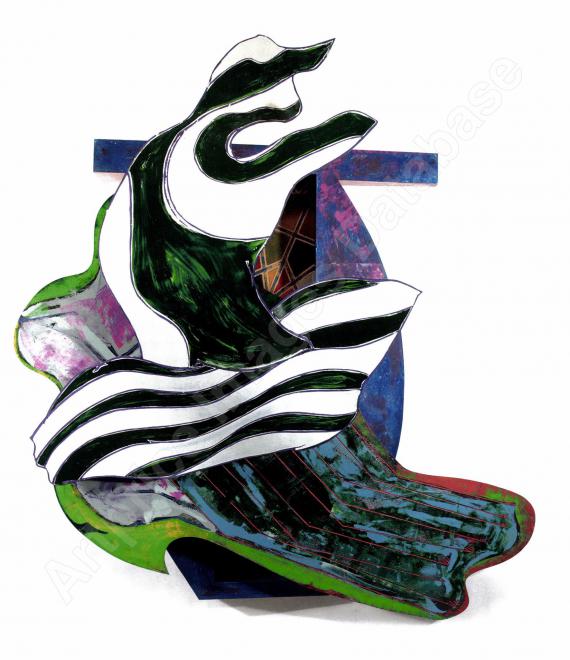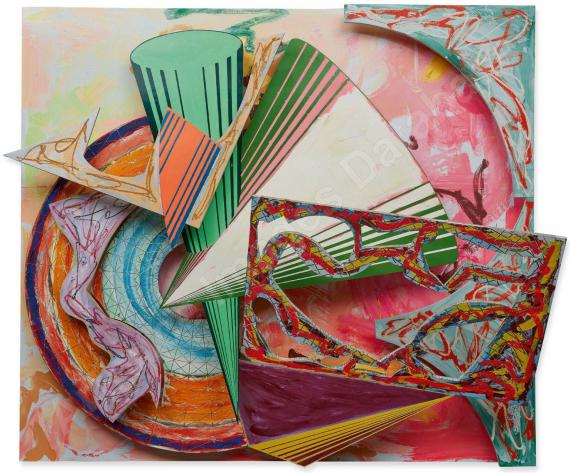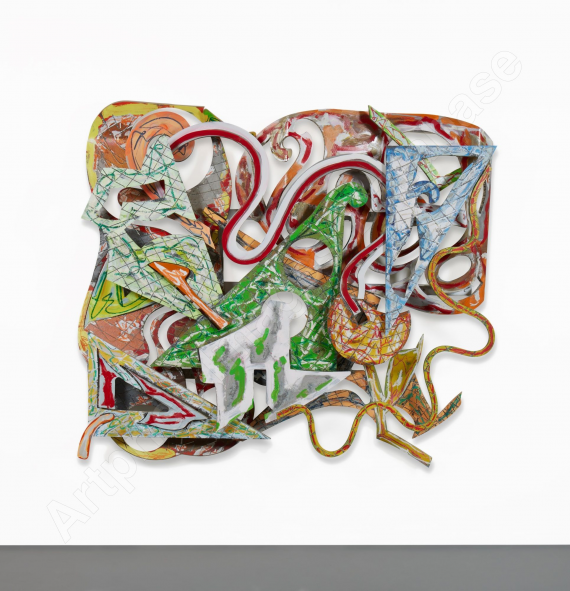Video
Altre immagini
Altre immagini
Altre immagini
Altre immagini
Altre immagini
Altre immagini
Altre immagini
Altre immagini
124000005
Frank Stella
The Pequod Meets the Rosebud (D-19, 1X), 1991.
Mixed media on aluminum
Stima: € 200,000 / $ 214,000
Le informationi sulla commissione, le tasse e il diritto di seguito saranno disponibili quattro settimane prima dell´asta.
The Pequod Meets the Rosebud (D-19, 1X). 1991.
Mixed media on aluminum.
Inscribed "D 19 1-X" on the reverse. Ca. 200 x 230 x 75 cm (78.7 x 90.5 x 29.5 in).
From the "Moby Dick" work series that the artist begun in 1986. Named after Herman Melville's novel (1851), it comprises works in a wide variety of techniques, including prints, indoor and outdoor murals, sculptures and reliefs. [JS].
• Stella's oeuvre is one of the internationally most pioneering positions in post-war modernism and contemporary art.
• Overwhelmingly expansive monumentality: an explosion of form and color.
• Boundless painting: while Stella's legendary "shaped canvas" overcomes the lateral boundaries of the canvas, his monumental reliefs dissolve the surface.
• From the important series "Moby Dick" for which he was inspired by Melville's classic novel. It marks the pinnacle of Stella's dissolution of the surface.
• Works from this series were a central part of the major Stella retrospective at the Whitney Museum of American Art, New York, in 2015/16.
• Further reliefs from this group of works can be found in important international collections like the Fondation Beyeler, Riehen/Basel, the Baltimore Museum of Art, the Walker Center, Minneapolis, and the Saatliche Kunstsammlungen, Dresden.
PROVENANCE: Galerie Hans Strelow, Düsseldorf.
Private collection Berlin (acquired from the above in 1993).
H. L. Alexander von Berswordt-Wallrabe, in: Frank Stella. Werke 1958-1976, Bielefeld 1977.
Mixed media on aluminum.
Inscribed "D 19 1-X" on the reverse. Ca. 200 x 230 x 75 cm (78.7 x 90.5 x 29.5 in).
From the "Moby Dick" work series that the artist begun in 1986. Named after Herman Melville's novel (1851), it comprises works in a wide variety of techniques, including prints, indoor and outdoor murals, sculptures and reliefs. [JS].
• Stella's oeuvre is one of the internationally most pioneering positions in post-war modernism and contemporary art.
• Overwhelmingly expansive monumentality: an explosion of form and color.
• Boundless painting: while Stella's legendary "shaped canvas" overcomes the lateral boundaries of the canvas, his monumental reliefs dissolve the surface.
• From the important series "Moby Dick" for which he was inspired by Melville's classic novel. It marks the pinnacle of Stella's dissolution of the surface.
• Works from this series were a central part of the major Stella retrospective at the Whitney Museum of American Art, New York, in 2015/16.
• Further reliefs from this group of works can be found in important international collections like the Fondation Beyeler, Riehen/Basel, the Baltimore Museum of Art, the Walker Center, Minneapolis, and the Saatliche Kunstsammlungen, Dresden.
PROVENANCE: Galerie Hans Strelow, Düsseldorf.
Private collection Berlin (acquired from the above in 1993).
H. L. Alexander von Berswordt-Wallrabe, in: Frank Stella. Werke 1958-1976, Bielefeld 1977.
"What is your white Wale?" - On Stella's series "Moby-Dick"
"What is your white Wale?" is the question that the Whitney Museum of American Art, New York, asked celebrity visitors to the major Stella retrospective (2015/16) with regard to Frank Stella's important series "Moby Dick". And the answer from the Indian-British writer Salman Rushdie, who performed part of the marathon reading of the 135-chapter novel "Moby Dick" (1851) over several days, was: "For a writer, the white whale is the book that torments you, that you don't know how to write. The thing you chase is the next thing that torments you and which you are tied to, like Ahab with harpoons to Moby Dick. You drown together."( quoted from: whitney.org/whitney-stories/moby-dick-marathon).
What the book means to the writer, the work to which he or she is fatefully and often agonizingly connected means to the artist. It challenges its creator time and again and must be pursued at the painful cost of all his strength. Just as Captain Ahab chases after the white whale Moby Dick lurking in the depths of the sea in the legendary novel by the American writer Herman Melville, published in London in 1851, the artist obsessively pursues the achievements of his own imagination that are still hidden in his mind and are at best completely new. Frank Stella himself, with his internationally outstanding oeuvre, is the best example of this incessant artistic struggle for completely new forms of expression.
Explosion of form and color - Stella's "Moby Dick Paintings" break down the boundaries of the surface
Stella's legendary "shaped canvases" of the 1960s initially inspired American and international post-war art in a decisive way and, due to their formal dissolution of the boundaries of the surface, also provided decisive impulses for contemporary art. In his reliefs, Stella immediately took a next significant step. He not only liberated the artist's pictorial idea from the traditional rectangular boundaries of the canvas, but also broke the boundaries of the surface, allowing the work to powerfully confront the viewer from the surface. Henceforth, Stella's pioneering oeuvre has captivated us with its enormous spatial presence, overcoming all previous artistic traditions in the blink of an eye. While the pure illusion of three-dimensionality on the surface had been a central characteristic of painting since the Renaissance, Stella suddenly made the third dimension of his abstract pictorial ideas a reality. Stella describes his working process with the following words: "I'm working away from the surface, but I don't want to be three-dimensional yet; that means, quite literally, [..] more than two dimensions, but not quite three, so for me 2.7 is perhaps a very good place to be." (quoted from: Frank Stella. Die Retrospektive. Arbeiten 1958-2012, Ostfildern 2012, p. 230).
Following the early reliefs, which date back to the 1970s and still have a very two-dimensional quality, were initially composed of mostly flat individual surfaces. Works from this period featured in the legendary "Zeitgeist" exhibition at the Martin-Gropius-Bau in Berlin in 1982. However, the highly dynamic and spatial reliefs of the "Moby Dick" work group, which Stella began in 1986, are regarded as the culmination of this process: In these powerful creations of color and form, Stella pushes his pursuit of the spatial dissolution of a painting's boundaries to the maximum. Our work "The Pequod Meets the Rosebud (D-19, 1X)", which takes its title from the 91st chapter of the "Moby Dick" novel, confronts and captivates the viewer with the full force of three-dimensionality. For Stella, however, these creations, which take real three-dimensionality to the extreme, are not sculptures, but still "paintings": "They are paintings because they function like a painting. They float. Sculptures don't float. You look at them like you look at pictures. They are designed as pictures." (Frank Stella, quoted from: Frank Stella. Die Retrospektive. Werke 1958-2012, Ostfildern 2012, p. 224). Hence this fascinating work, despite its enormous spatiality, suddenly appears "only" a like two-dimensional painting when viewed from a central perspective, until you move just a little and the form suddenly bursts out of the surface with full force. Here Stella has reversed the traditional spatial illusion of painting in a fascinating way: his painting does not simulate three-dimensionality on the surface, but Stella's painting is three-dimensional and - when seen from the right perspective - offers a virtuouso play with the illusion of two-dimensionality.
Frank Stella: Protagonist of American post-war modernism and contemporary art
In addition to the literary model, the captivating imagery of the 1956 American film adaptation starring Gregory Peck as Captain Ahab, who is constantly chasing the white whale, was certainly a decisive inspiration for the spectacular formal vocabulary Stella had chosen. Like an unleashed monster of color and form, the work bursts out of the surface of the wall with full force. The scenes in the film in which people and harpoons with ropes are stuck in the wide-open mouth of "Moby Dick", the giant white whale, and entire boats burst into pieces are legendary - elements of form that are also partly recognizable in Stella's painting. Thus "Moby Dick's" force and determination in the fight against the harpoons and ropes of the whale hunters ultimately also resembles Stella's successful artistic struggle against the shackles of art-historical tradition, from which he frees himself time and again and which he ultimately leaves far behind him in the powerful creations of the "Moby Dick" series.
From early on, Stella's work featured in important exhibitions of American post-war art, such as "Sixteen Americans" (Museum of Modern Art, New York, 1959), "The Shaped Canvas" (Solomon R. Guggenheim Museum, New York, 1964/65), "Systemic Painting" (Solomon R. Guggenheim Museum, New York, 1966) and "Structure of Color" (Whitney Museum of American Art, New York, 1971). Today it is considered one of the most important positions in American art. As early as 1970, the Museum of Modern Art, New York, honored the 33-year-old artist with a first grand retrospective exhibition, which included his famous "shaped canvas". William Rubin, former modern art curator at the Museum of Modern Art, described Stella's groundbreaking significance in 1987 in the catalog for the exhibition "Frank Stella: Works from 1970-1987" as follows: "Stella had contributed to the already varied vocabulary of American art [..] one of the few genuinely new paths for the continued development of major non-figurative art." In his spectacular "Paintings" of the "Moby Dick" series, Stella impressively demonstrated his enormous artistic potential: Stella took the third dimension in painting to a maximum before he subsequently turned almost inevitably to sculpture. [JS]
"What is your white Wale?" is the question that the Whitney Museum of American Art, New York, asked celebrity visitors to the major Stella retrospective (2015/16) with regard to Frank Stella's important series "Moby Dick". And the answer from the Indian-British writer Salman Rushdie, who performed part of the marathon reading of the 135-chapter novel "Moby Dick" (1851) over several days, was: "For a writer, the white whale is the book that torments you, that you don't know how to write. The thing you chase is the next thing that torments you and which you are tied to, like Ahab with harpoons to Moby Dick. You drown together."( quoted from: whitney.org/whitney-stories/moby-dick-marathon).
What the book means to the writer, the work to which he or she is fatefully and often agonizingly connected means to the artist. It challenges its creator time and again and must be pursued at the painful cost of all his strength. Just as Captain Ahab chases after the white whale Moby Dick lurking in the depths of the sea in the legendary novel by the American writer Herman Melville, published in London in 1851, the artist obsessively pursues the achievements of his own imagination that are still hidden in his mind and are at best completely new. Frank Stella himself, with his internationally outstanding oeuvre, is the best example of this incessant artistic struggle for completely new forms of expression.
Explosion of form and color - Stella's "Moby Dick Paintings" break down the boundaries of the surface
Stella's legendary "shaped canvases" of the 1960s initially inspired American and international post-war art in a decisive way and, due to their formal dissolution of the boundaries of the surface, also provided decisive impulses for contemporary art. In his reliefs, Stella immediately took a next significant step. He not only liberated the artist's pictorial idea from the traditional rectangular boundaries of the canvas, but also broke the boundaries of the surface, allowing the work to powerfully confront the viewer from the surface. Henceforth, Stella's pioneering oeuvre has captivated us with its enormous spatial presence, overcoming all previous artistic traditions in the blink of an eye. While the pure illusion of three-dimensionality on the surface had been a central characteristic of painting since the Renaissance, Stella suddenly made the third dimension of his abstract pictorial ideas a reality. Stella describes his working process with the following words: "I'm working away from the surface, but I don't want to be three-dimensional yet; that means, quite literally, [..] more than two dimensions, but not quite three, so for me 2.7 is perhaps a very good place to be." (quoted from: Frank Stella. Die Retrospektive. Arbeiten 1958-2012, Ostfildern 2012, p. 230).
Following the early reliefs, which date back to the 1970s and still have a very two-dimensional quality, were initially composed of mostly flat individual surfaces. Works from this period featured in the legendary "Zeitgeist" exhibition at the Martin-Gropius-Bau in Berlin in 1982. However, the highly dynamic and spatial reliefs of the "Moby Dick" work group, which Stella began in 1986, are regarded as the culmination of this process: In these powerful creations of color and form, Stella pushes his pursuit of the spatial dissolution of a painting's boundaries to the maximum. Our work "The Pequod Meets the Rosebud (D-19, 1X)", which takes its title from the 91st chapter of the "Moby Dick" novel, confronts and captivates the viewer with the full force of three-dimensionality. For Stella, however, these creations, which take real three-dimensionality to the extreme, are not sculptures, but still "paintings": "They are paintings because they function like a painting. They float. Sculptures don't float. You look at them like you look at pictures. They are designed as pictures." (Frank Stella, quoted from: Frank Stella. Die Retrospektive. Werke 1958-2012, Ostfildern 2012, p. 224). Hence this fascinating work, despite its enormous spatiality, suddenly appears "only" a like two-dimensional painting when viewed from a central perspective, until you move just a little and the form suddenly bursts out of the surface with full force. Here Stella has reversed the traditional spatial illusion of painting in a fascinating way: his painting does not simulate three-dimensionality on the surface, but Stella's painting is three-dimensional and - when seen from the right perspective - offers a virtuouso play with the illusion of two-dimensionality.
Frank Stella: Protagonist of American post-war modernism and contemporary art
In addition to the literary model, the captivating imagery of the 1956 American film adaptation starring Gregory Peck as Captain Ahab, who is constantly chasing the white whale, was certainly a decisive inspiration for the spectacular formal vocabulary Stella had chosen. Like an unleashed monster of color and form, the work bursts out of the surface of the wall with full force. The scenes in the film in which people and harpoons with ropes are stuck in the wide-open mouth of "Moby Dick", the giant white whale, and entire boats burst into pieces are legendary - elements of form that are also partly recognizable in Stella's painting. Thus "Moby Dick's" force and determination in the fight against the harpoons and ropes of the whale hunters ultimately also resembles Stella's successful artistic struggle against the shackles of art-historical tradition, from which he frees himself time and again and which he ultimately leaves far behind him in the powerful creations of the "Moby Dick" series.
From early on, Stella's work featured in important exhibitions of American post-war art, such as "Sixteen Americans" (Museum of Modern Art, New York, 1959), "The Shaped Canvas" (Solomon R. Guggenheim Museum, New York, 1964/65), "Systemic Painting" (Solomon R. Guggenheim Museum, New York, 1966) and "Structure of Color" (Whitney Museum of American Art, New York, 1971). Today it is considered one of the most important positions in American art. As early as 1970, the Museum of Modern Art, New York, honored the 33-year-old artist with a first grand retrospective exhibition, which included his famous "shaped canvas". William Rubin, former modern art curator at the Museum of Modern Art, described Stella's groundbreaking significance in 1987 in the catalog for the exhibition "Frank Stella: Works from 1970-1987" as follows: "Stella had contributed to the already varied vocabulary of American art [..] one of the few genuinely new paths for the continued development of major non-figurative art." In his spectacular "Paintings" of the "Moby Dick" series, Stella impressively demonstrated his enormous artistic potential: Stella took the third dimension in painting to a maximum before he subsequently turned almost inevitably to sculpture. [JS]
124000005
Frank Stella
The Pequod Meets the Rosebud (D-19, 1X), 1991.
Mixed media on aluminum
Stima: € 200,000 / $ 214,000
Le informationi sulla commissione, le tasse e il diritto di seguito saranno disponibili quattro settimane prima dell´asta.




 Lot 124000005
Lot 124000005 



